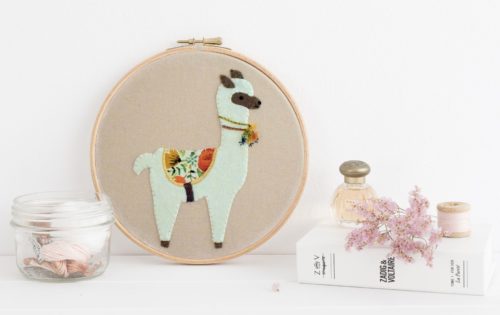
Some embroidery mistakes are just unfortunate and these form an inevitable part of your learning curve – but others are totally avoidable – if you know to watch out for them in the first place that is!
Want more hints & tips? Then click below to get our free newsletter – you’ll even get some fab free patterns too…
1. Not reading the instructions properly
It may seem a bit like stating the obvious, but if you’re in a hurry to begin a new project it’s easy to tell yourself it’s all
perfectly obvious and skip this step. Bad idea! Always read the instructions carefully – twice is good! If you don’t take note, then you may discover you’ve been using the wrong type, colour, or number of strands of floss. This may mean you could run out of thread before you reach the end, your stitching may appear thin and gappy – or thick and lumpy – and disappointingly your project won’t look as you had hoped.
2. Choosing the wrong transfer method
There are so many different ways of transferring your design from paper to fabric. Sometimes it won’t matter if the transfer lines are permanent as your stitching will cover all the lines. But sometimes your lines won’t be completely covered – perhaps if you’re working an open or lacy design without a solid outline. In this case you will need to be able to remove the transfer lines once you’ve finished stitching. Always take time to consider the nature of the finished design and the stitches you plan to use before you choose your transfer method. If your design lines won’t be
completely covered, choose a transfer method that can be removed after your work is finished. Ceramic chalk pencils, dressmaker’s carbon, water-soluble pens and even my favourite Sulky Sticky Fabri Solvy are all good choices in this instance.
3. Choosing the wrong needle
If your needle is too large this may result in holes in the fabric where your needle and thread enter and exit. Alternatively if your needle is too small it will be difficult to thread and hard to pull through the fabric, resulting in wear and tear on the thread which will eventually fray and break, and will make your fingers sore too. The type of needle you choose is also important. Freehand surface embroidery requires a sharp needle as it needs to pierce the fabric, whilst a ballpoint needle should be used when the needle needs to pass between threads in the fabric without piercing them, as in counted cross stitch, pulled thread, and Hardanger embroidery.
4. Choosing the wrong fabric
Most surface embroidery techniques require a nice firmly woven foundation. Using a background fabric that’s too loosely woven may well result in poorly-formed stitches. You can overcome this problem though, if there’s a fabric you particularly want to use, by fusing interfacing or a more firmly woven fabric to the reverse of your chosen fabric before you begin stitching.
5. Cutting your thread too long
As your thread passes through the fabric multiple times it is experiencing wear and tear, and the longer your thread the more wear it will experience. You may not notice the changes immediately, but if you use very long lengths of floss your stitching won’t look as bright and fresh and glossy as it would if you used shorter lengths. Additionally, longer threads are more likely to tangle , leading to frustrating knots and to wasted time, trying to pick out knots. They’re also more tiring to use as your wrist and arm has to work harder to pull them through the fabric. As a general rule of thumb, my mum used to tell me to use threads around the length of my arm from wrist to elbow – and certainly no longer than around 18” maximum.
6. Starting your stitching with a knot
Knots are bulky and will prevent your work from lying flat when pressed and mounted. They wobble around and may work loose, causing your carefully stitched work to begin to unravel. Begin your first thread with a waste knot, and subsequently begin and end by weaving the tail of the thread in and out of previously worked stitches.
7. Working in poor light
I don’t know how embroiderers of the past managed, as even though you think you can see your work perfectly by normal household lighting, you are probably wrong. Ordinary lights don’t show true colours and may cast odd shadows that are often the cause of messy or inaccurate stitches. If you don’t have a proper daylight lamp for sewing, then consider in investing in one – or even fitting a daylight bulb to an ordinary light – you will be amazed at how much difference it will make to your embroidery.
8. Don’t be afraid of mistakes – or you’ll be worried about trying anything new
Try to view them as a learning experience, or even an opportunity for creating a new technique! Remember, you’re usually the only one who will notice your mistakes, and you’re always your own worst critic. Whatever you do, don’t let a mistake keep you from stitching!
![]()
Want more hints & tips? Then click below to get our free newsletter – you’ll even get some fab free patterns too…

I was always taught that it doesn’t matter if mistakes (paragraph 8), are made that is how you learn anything. Try different things, and always read the instructions and always use the correct needles.
Julie xxxx
Exactly, if you don’t make mistakes you’ll never learn! Xx
I never realized types of sewing needles made a difference. Your explanations made a lot of sense. Thanks so much for educating an old timer. Its something I can teach to my grandchildren. Again, thanks.
Aw you’re very welcome Patsy, so pleased you found it useful 🙂
I have a lot to learn,so I going take one inch at a time.
Thanks for the encouragement.
Peggy